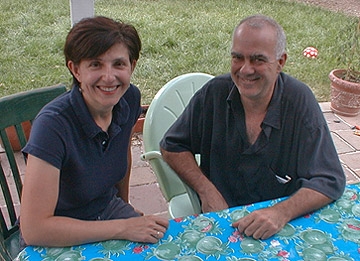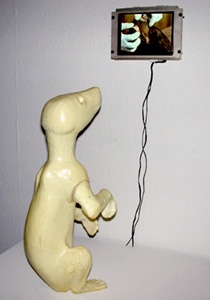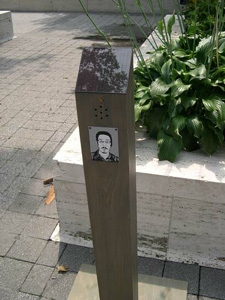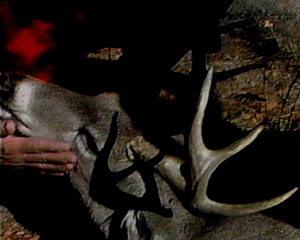Feature: Conversations
Mary Tsiongas: On Leaving the Bay Area
Digital media artist Mary Tsiongas was born and spent her early years in rural northern Greece before emigrating with her family to the U.S. in 1967. After studying research biology in Boston, she moved to the Bay Area in 1991. She received her MFA in film, video, and performance from the California College of Arts and Crafts (now known as CCA), Oakland in 1993. In 2001 she moved to Albuquerque, New Mexico to take a teaching job at the University of New Mexico (UNM). In June 2005, Scott MacLeod interviewed her at her home. This is the first of a series of interviews by MacLeod with artists who have recently relocated from the Bay Area.
Mary Tsiongas I first came out to the Southwest in 1987. It was an interesting experience for me because the terrain is so different from the Boston area. I felt an immediate affinity to it, especially the sunny dry climate. But then I moved to the Bay Area for a number of years. And coming from there to here, it’s been harder to connect to this place.
Albuquerque has a different kind of diversity than the Bay Area. I was keenly aware of that in the first two years. Here there’s a larger population of Hispanics and Native Americans, with a very small population of Asian and African Americans. UNM has roughly 25,000 students, and the College of Fine Arts is a small college within a large university. I was clearly reminded that this is a poor state and that the university (as well as the college) has a limited amount of resources, so the message was “don’t ask for much.” But I work with a decent group of people and my students are really great. It’s a state university, so the students are a lot more diverse than my neighborhood. We get some international students as well. For example, this semester we had students from the Czech Republic and from Glasgow. When I was hired, there was no new media area in the department. I felt something like that was needed here, so I started an electronic arts area.
Scott MacLeod Is there a subculture in Albuquerque that can support digital media work? Someplace where students can present work?
MT I think Santa Fe has more than Albuquerque. There are some commercial galleries in Albuquerque, and we’re lucky to have quite a few galleries at UNM as well. And now there is a new arts lab center at UNM that will hopefully bring in new digital media work. What’s exciting about Albuquerque is that space is still cheap enough here to start new exhibition sites. Recently three UNM graduate students started Donkey Gallery, which has been quite successful.
Albuquerque feels like it’s in the middle of nowhere, and I actually appreciate that now. I appreciate that you can see the edges. Sometimes when I’m driving and I’m up at the top of a hill, and I look beyond, there’s no fooling yourself about where you are. In the Bay Area you can fool yourself a little. Oakland and Albuquerque are similar-sized cities; it’s just that Oakland has the water, Berkeley, San Francisco around it. Albuquerque has the desert. If you started walking without water, you’d probably die. There’s something humbling about that.
SM The work you did in the Bay Area used sophisticated technology to make deceptively simple pieces that described systemic, ontological processes. The distancing effect created by the use of digital media somehow evoked both the disappearance of the natural world and its immanence. Has your relocation to this area begun to affect your work?
MT The work I did in ‘99, right before I left the Bay Area, was, ironically, about trying to find a sense of home in a place, in the natural world. Since moving here, I have become hyper aware of one’s impact on the environment. Every time I do something with water, I say to myself “Oh, I’ve just wasted water. It’s the desert, don’t waste water.”
I think initially my artwork was much more directly about some sort of spiritual journey or exploration, and now it’s not so overtly that, because I feel in some ways it doesn’t matter where you are, and it doesn’t matter what you’re doing; in essence it’s how you’re doing it.
SM Is there a difference in scale in what you’re working on now?
MT I was doing a lot more installations in the early 90s, and it’s definitely shifted to much smaller work. And much more simple work. I think the work took up a lot of space before and now I’m much more interested in trying to evoke what I was trying to evoke in a large installation in a small object, or a wall piece. The last body of work I did was mostly on the wall, which surprised me, because before then it had been three-dimensional, you walked around it, interacted with it. In some ways I’ve learned just to simplify things. In many ways it’s always been about editing: I find the more I work, the more I’m going towards a more stripped-down version of what I usually start with.
I don’t feel that technology is my orientation when I start creating work. I’m drawn to technology in many ways. I definitely find it magical and appealing, but I try to use it in a very simple state. What I mean by magic is the magic we experience when we see a magic trick that is done really well and it fools you, even though you know how it’s done. I just love that, and I think that’s what I like about technology too, you can know how it’s done, but for a second you can fool the viewer, or entertain them in that way. I’ve always liked that correlation with magic tricks.
SM Did you collaborate with others on the technological issues? Have you found new collaborators here?
MT In the Bay Area, I was collaborating with Guy Marsden, an artist/engineer who also helps a lot of other artists. He helped me with one piece when I first moved here, a solar-panel piece. I was interested in making something self-sufficient, that I didn’t have to plug in. I’m tired of plugging things in. I want something that works whether I’m there or not. I’ve been trying to get more self-sufficient. If I can’t figure out how to do it, I’m not going to ask somebody else—I’ve gotten to the point where I’m trying to keep it bare bones simple. One, I like to teach myself how to do things, so it helps me in that way, and two, I’d rather have it simple so I can fix it myself. If I can’t fix it myself, I don’t want to do it.
This body of work that I had done right before I left California, called Genus Loci, was looking at our relationship to the environment in terms of home: how do you choose where you live, and what does that mean, what’s the impact on one’s own being and work? That work led me to consider the relationship to the wilderness, how much time people spend in the wilderness and how much time we spend now, which is practically nil.
SM “We” personally or “we” culturally? Or both?
MT Both. Me personally because I spend less time out there camping and hiking, and even then, it’s a mediated experience, and that’s kind of what I was looking at, it’s always a mediated experience. The wild has diminished dramatically in our lifetime. I read this book recently called A Sideways Look At Time. The author, Jay Griffith, compares our loss of “wild time,” as she calls it, free time, to our diminishing wilderness. Where people live now as opposed to what’s wild is the reverse of what it was a couple hundred years ago.
I moved from looking at the environment and that kind of relationship, to looking at wilderness and who has contact with the wild now. That shifted me to my recent work, which is about time, in terms of our relationship to time. That’s a very broad idea, but more specifically to how we experience the passing of time but also time to be doing something besides what we’re supposed to be doing.
In order for me to do creative work, I need free time, wild time, whatever you want to call it. So if that is not valued, it’s a big problem. It’s saying, “You’re not efficient.” You know: somehow you’re supposed to be efficiently using every moment of your day? So what is that time that doesn’t have any kind of use? I think that [loss of wild time] is really a tragic thing. I have friends who can carve that out and do it, who have managed somehow to not work, and live very unstructured lives and depend on grants or the kindness of strangers or whatever. I respect that because in some ways it’s the only way to do it.
SM A lot of my friends in the Bay Area live like that, teaching four courses at three universities in two cities, writing grants, a little of this a little of that. I’ve never been able to switch gears so often on a daily basis. I get more artwork done when I’m employed full-time in totally non-art-related jobs. I’m curious about how you are adjusting. Your job is probably pretty demanding.
MT One of the reasons I took this job was that I didn’t want the stress of trying to find classes every semester in several different schools. I taught at the San Francisco Art Institute primarily, but at California College of Arts and community colleges as well. The commuting and hustling were driving me crazy.
And then I had a kid, and realized I can’t maintain this kind of life and give this child at least some of my time, and actually enjoy it. As I’ve gotten older, I’m much more pleasure-oriented. I’ve got to be enjoying what I’m doing. I think that’s why the work has become simple. When I got this job, I thought it would focus me, I’ll have one job, not a million jobs, it’s a slower place, there’s not as much happening here, it’s not the kind of place where you feel like you’re missing something by blinking, like in the Bay Area.
So I wanted that shift and I got it. The first two years were hard, cause I felt like I was in exile, exiled out of Paradise. It was like: what have I done? There’s nothing happening here! The second year, I brought several artists I knew to lecture at the university. And then by the third year, I thought, you know, this is a place where I could actually balance my work, family life and teaching. I’m closer to that balance now.
When I go back to the Bay Area and I see how my friends are all juggling things, this feels a little saner. And I agree with you: because I’m older, I can’t do a million and one things anymore. I really would rather just enjoy doing my artwork. And I think my values have changed as well. What I’m valuing, what I’m willing and not willing to put up with, has changed.
SM Such as?
MT If I’m invited to do a show that’s not worth the effort, I may not do it. I don’t mean small show spaces— I’m definitely interested in alternative small spaces, but if it’s something that feels like it’s going to be more work than it’s worth, or somebody’s asked for a piece— if it’s an old piece that would be a nightmare to set up, I’ll just say no now.
SM How has moving here impacted your career?
MT I’m still very connected to the Bay Area, that’s where my network is, that’s still predominantly where I’m showing. I have a show in November at Stanford and the Exploratorium is currently showing the light-activated books. I’ve also started being more involved in shows here in New Mexico. I was in a beautiful show at the Museum of Fine Arts in Santa Fe called Embodied, that Laura Addison curated, and am currently in a show here at the UNM Art Museum as well.
Because my work and career took this hiatus, having a kid and taking a new job, I feel it’s not where I would like it to be. I definitely would like to be selling my work more. I wouldn’t say I’ve changed my work in order to sell it, but I have stopped doing installations because of the cost and space considerations. I would only do a complicated installation if someone commissioned me to do one. It’s a survival decision.
SM The adjustments we have to make as our lives change are complex and subtle at the same time. For me the oddest thing is that the world I looked forward to growing up into is gone. The society, that community of people that I thought I was going to be “joining” doesn’t exist anymore.
MT The first year here was in many ways a year of grieving. Grieving the loss of being in the Bay Area, but more importantly, the loss of my friendships there. I’ve maintained those friendships, but they are different now. I can’t stop by and hang out. That was a big thing for me. The Hunting work I did— I started doing it and I didn’t know what I was doing, but it ended up— at the end of it, I realized it was work about grief and loss. And loss on a lot of different levels. Not just personal loss, but the loss of a certain way of living, in the culture, in this country, in the world at this time.
I actually started working on the hunting pieces right before I moved from the Bay Area. When I moved here I noticed hunting stores were quite prevalent. I took it as a sign to continue doing the work. The work explores hunting as a complex activity that once connected us to the land and to wild life. At times the work departs from the actual theme of hunting and becomes a metaphor for the artistic process. I mined the Internet, hunting stores and videos for the images I ended up using in the pieces. Then I pulled out images I found ironic or perplexing; like images of tenderness of the hunter toward the animals. The work also became a metaphor for how one might envision living in a paradoxical world, and a metaphor for how one might perhaps maneuver between the intricacies of culture and nature.
SM If we no longer have the choice of living in the place we’ve thought of as home, then we are making decisions about what to call “home.” We need to create that somehow. You have a relationship to a daughter, a relationship to the kind of empowerment you have here that you didn’t have in the Bay Area, to possibilities for pleasure and creativity - is there an analogue in your work to this question of how to describe home; a kind of arbitrary, artificial description of the evanescent?
MT I feel like I’m just starting to do that work. This whole exploration into time is very much about that. Because it kind of removes the core, in terms of place, moves it to a self. Meaning that it’s no longer about being in Greece, or in the Bay Area or wherever. It’s more about a state of being and experience.
SM Internalizing instead of externalizing.
MT Right. And in some ways what I experienced with my grandparents and that childhood time period—now I have to shift and be on the other side of it. I was a child who had that world around her, and now, in some ways, I have to create that world for somebody else, my daughter. But also I have to create it for myself. Because that life has completely changed, not just for me. I think the “Hunting” work was for me the coming to that realization.
Now I’m moving into this “time” work, I’m calling it time. I joked about starting to do work about time so I could actually have time. So to me it’s okay to forget about the process being about something; I’m going to try to have the work be the experience. I’m much more interested in experiential work, not so much performance but performative. Maybe the work comes from a place where you’re actually doing, whether it’s gathering vegetables and fruits from your neighbors or experiencing something for a period of time and making work about it.
So this has been a big shift for me, the feeling that I can be at home anywhere. Maybe I’m coming to terms with a more nomadic experience. Wherever I lay down my camp, I can still connect to the people who are part of my tribe, I just don’t physically see them as much anymore. The tribe has dispersed but we’re still connected. It’s having faith in those connections, and understanding this different way of being.




